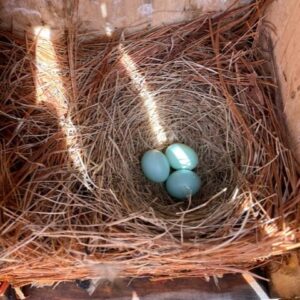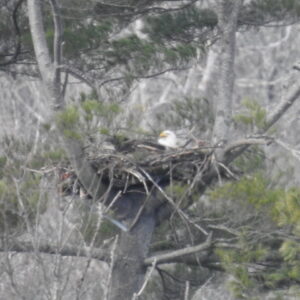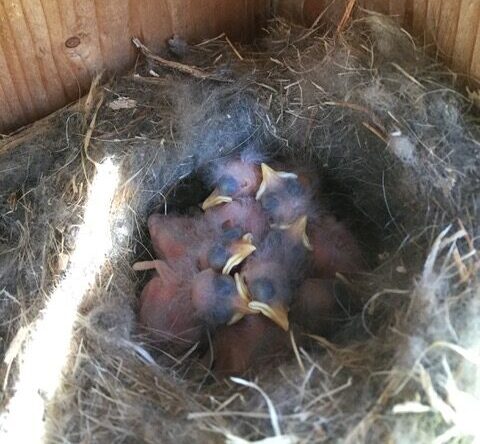Volunteer and long-time birder, Stan Wakefield, shares regular updates and pictures on bird nesting activity at BRLT’s bird boxes monitored at Oak Point Farm, Singing Meadows, Lobster Cove Meadow, Penny Lake, and Zak preserves. Data is also reported to NestWatch, a citizen-science monitoring program developed by the Cornell Lab of Ornithology and used nationwide to track the status and trends in the reproductive biology of birds. We encourage readers to check back frequently from April-August to keep up on all of the changes throughout the season.
——————————————————————————————————————-
We’re not even at the end of April yet, and we currently have at least 44 (and possibly 45) Bluebird eggs in nest boxes on four of our five preserves! The Blues have gotten an early and fast start on their breeding season.
As of this past weekend, Singing Meadows has a whopping 25 eggs being incubated, with 5 eggs in each of 5 different nest boxes. We’ve never seen those numbers in the many years we’ve been doing this.
Oak Point Farm is off to a slightly slower start with at least 9 Bluebird eggs in 2 different nest boxes. There may actually be 10 eggs but one stubborn female Blue refused to let us count how many eggs she’s incubating.
Zak had 5 eggs in one nest box, and Lobster Cove Meadow also had 5 eggs in one nest box.
Tree Swallows have laid claim to three nest boxes (one each at Penny Lake, Zak, & Oak Point Farm) but they have not deposited any eggs in any of those boxes. That should change this week.
The spring migration is ramping up quite nicely with peak migration for Maine still about a week or two away. Lots of the usual suspects of many varieties are being seen in steadily increasing numbers (including warblers, flycatchers, sparrows, hawks, herons, etc.). The folks who count migrating raptors during the spring at Bradbury Mountain State Park are reporting significant numbers of Broad-winged Hawks (over 1,100), Ospreys (over 380), Sharp-shinned Hawks (over 350), and American Kestrels (over 290) so far.
Our preserves are also coming alive with the sounds of birds calling and establishing breeding territories. An app for your smart phone from Cornell University (Merlin Bird ID) can help you identify most of the birds you’re hearing but cannot find. The app can also help you identify many birds by their relative size, color, and behavior. The app is free and can really help you enjoy our preserves even more.
For those who like to provide nectar for Hummingbirds, now would be a good time to clean those feeders, fill them with nectar (4 parts water, 1 part granulated sugar), and get them hung where these flying gems can find them. They should start showing up here in the Midcoast in the next week or two. Please be sure to keep those feeders clean throughout the season.
With the weather improving every day, now is a great time to get out on our land trust preserves and see what’s happening!
The bird breeding season and the spring migration are picking up speed! Since last week, we saw an uptick in the number of bluebird eggs deposited in nests on four (out of five) of our land trust preserves. Furthermore, the number and variety of migrating birds we’re seeing is growing daily.
Four of six nest boxes at Singing Meadows have bluebird eggs in them. Zak Preserve doesn’t have any eggs yet but that will likely change this week with bluebirds in one nest box and tree swallows in the other. Penny Lake has bluebird eggs in one of three nest boxes and tree swallows are likely to deposit eggs in another. Two of the five nest boxes at Oak Point Farm have bluebird eggs in them with tree swallows possibly preparing to deposit eggs in one other. One of two Lobster Cove Meadows nest boxes now has 4 bluebird eggs in it with tree swallows possibly preparing to do the same in the second box.
You may recall that tree swallows, like bluebirds, are cavity-nesting birds so the nest boxes on our preserves are attractive to them for breeding. Accordingly, it’s not unusual to see this “sharing” of nest boxes between the two species. By the way, we can tell which nest boxes are being used by Tree Swallows even before they deposit their white eggs: they typically line their nests with feathers while the bluebird’s blue eggs are deposited in grass-lined nests. Although we might prefer to see bluebirds nesting in ALL the nest boxes, we are “equal opportunity” bird landlords, so we do not object to (nor do we evict) tree swallows using the nest boxes.
Inspection of nest boxes last week on five BRLT preserves indicates that our Bluebirds have been very busy. All five preserves had at least one nest completely built and one nest (at Singing Meadows) even had three eggs in it! Many of the nest boxes on our preserves had early signs of Bluebird nest construction, but there were several with completed nests that appeared ready to have eggs deposited in them. Good weather over the past several days will have provided the Blues with the opportunity to finish nest building and get on with the business of egg-laying. We anticipate that inspections this week will reveal many more completed nests with eggs in several of them. Stay tuned!

The first Bluebird eggs of the season on a BRLT preserve
We’re now into week 2 of this season’s bird breeding activity, and we’ve seen evidence of nest building on four of five BRLT preserves.
Singing Meadows has one nest box with Bluebird nest building in progress, while a second nest box has very early evidence of a different species building a nest. We should know more about this by next week.
Lobster Cove Meadow has a completed Bluebird nest in one nest box while the other box is still empty.
Oak Point Farm has one nearly complete Bluebird nest in one of five nest boxes.
Both nest boxes at Zak preserve are showing evidence of Bluebird nest building.
All three nest boxes at Penny Lake remain empty, but we don’t expect that to last long.
Bluebirds have been seen at all five preserves and appear to be ready to add nests to more nest boxes and even begin to deposit sky-blue eggs in at least two nests within the next few days. Stay tuned — we’re just getting started!

Female Bald Eagle on nest March 16, 2024





